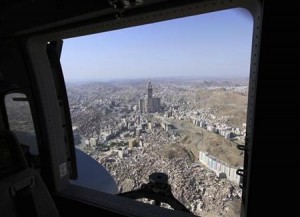Future Development of Mecca Aims to Fit heritage
(Reuters) – Future development in the Muslim sacred city of Mecca will be more in tune with traditional architecture, the mayor says, but for now residents worry that Islam’s holiest sites are disappearing behind skyscrapers.
The historic city, the birthplace of Islam, is studded with dozens of yellow and red cranes and metal scaffolding aimed at increasing hotel space and improving facilities to make the annual haj pilgrimage safer and easier.
As more than 2.5 million Muslims from across the world flood Mecca’s narrow streets for the annual pilgrimage, however, many visitors and residents point to a government-owned 600-meter (1,970 feet) tower surmounted by an extravagant clock as evidence development has moved too quickly.
“The building regulations in the city take into consideration the width of the streets, central locations and do not allow the building of skyscrapers…what was built was that,” Mayor Osama al-Bar told Reuters when asked about the tower.
Future projects “will be far from the grand mosque by 300 meters … The buildings will have reasonable heights between 8 to 10 floors and will have the Meccan style,” he said.
Within six years, the government hopes to reinforce the infrastructure surrounding Mecca’s Grand Mosque, home to the cube-shaped Kaaba toward which Muslims the world over turn in prayer, replacing congested narrow roads with new ones, installing foot bridges for pedestrians and a four-line metro.
On Tuesday, Crown Prince Nayef, whose ruling Al Saud family bases its legitimacy in part on its guardianship of Islam’s holiest sites, said the development that had already taken place would “be little compared to what will happen.”
“We want to evolve Mecca, not change it,” said Sami Angawi, founder of Hajj Research Center and an expert on Mecca.
Angawi, who is originally from Mecca, has not stepped into his city for the past two years because he is unhappy about the way that it is being transformed.
“I love Mecca and cannot see the beloved (sanctuary) of the Prophet being destroyed and handled this way,” said Angawi, who shares a belief with many Muslims that Mecca is a holy place where change must be made in a delicate manner.
CREAKING INFRASTRUCTURE
An hour before evening prayer, the marble floor around the Grand Mosque is hardly visible as millions of worshippers stand side-by-side, lining their prayer mats outside the overflowing mosque to reserve a spot in anticipation for the call to pray.
The pilgrimage was once the culmination of an arduous desert journey over perilous weeks or months, but with the advent of modern transport, the number of hajis, or pilgrims, has risen to millions, gridlocking the city’s roads and compromising safety.
Deadly stampedes, tent fires and other accidents have several times caused hundreds of deaths, forcing the government to spend lavishly on new infrastructure.
“For sure (the expansion) will be good for pilgrims because usually there are huge numbers of pilgrims, especially during prayer times,” Ahdab Seif, an Egyptian pilgrim, said outside the Grand Mosque.
Long-term projects around the mosque will include hotels, malls and cafes. Developments in the suburbs include housing estates and a park for residents who have been made to relocate from the city center.
“Mecca is known to be an old city … it has some old haphazard buildings located near the Grand Mosque and this project will reshape the face of Mecca and raise the capacity and services of the city,” Bar said.
“By 2020 we hope that results will be visible as major parts of the projects will be complete,” he said, sitting behind his wooden desk at the Mecca municipality.
Among the announced projects, which will cost more than $30 billion, is a historic expansion of the Grand Mosque to add 400,000 square meters and add shaded areas to shelter worshippers from the scorching desert sun.
RAPID DEVELOPMENT
The clock tower of the King Abdulaziz Endowment, which is visible for miles around and stands next to the Grand Mosque, has been the focal point of criticism.
“What is not nice is that the outside design is not traditionally Arabic… What they created looks like the buildings in Australia, it does not give a feel of Arabs and Mecca,” said Wafa Sbbet, 50, who came from Sydney for the haj.
The tower, which overlooks the Kaaba, was built over a demolished 18th-century Ottoman fort on a prominent Mecca hillside, now flattened to the ground.
“This is a sanctuary … My objection is not about expansion, or increasing capacity for pilgrims or developing Mecca. My objection is about how it is done,” Angawi said.
“This tower does not respect the dignity, sanctity and culture of the Kaaba … it has demolished a whole mountain.”
Mecca residents, who once lived a few steps from the Grand Mosque, say they are being pushed away from the city-center to make way for hotels and restaurants that will cater to visiting pilgrims.
A square foot of land around the Grand Mosque has in some cases reached up to $18,000, Bar said, significantly higher than average prices of around $4,420 in Monaco.
Property consultant Jones Lang LaSalle could not corroborate those prices but confirmed that the land around the Grand Mosque is the most expensive real estate in the world.
“Mecca is the heart of the Islamic world… what we are doing is changing the heart from a natural heart to a mechanical one,” Angawi said.
“Now we should review and stop any project that does not respect the scale of the Kaaba and the environment of the holy sanctuary … Take the bulldozers and dynamites out of Mecca.”
(Editing by Sonya Hepinstall)


















